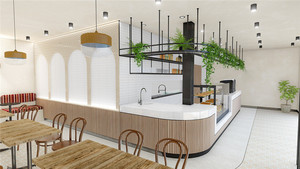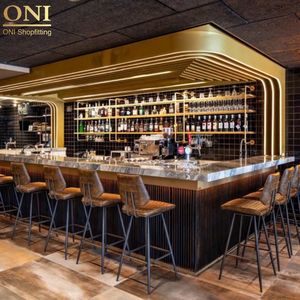(128718 products available)

























































































































































































































A bar counter design is an area in a home, restaurant, or pub where drinks are served. It is also known as a bar counter. Bar counters are designed to be social spaces where people can sit and enjoy drinks together. They come in different designs to suit various spaces. The bar counter consists of a raised surface for drinks, stools or chairs for seating, and sometimes mirrors, lights, and shelves to display bottles and glasses. It is a place where people go to relax, unwind, and socialize with family and friends.
There are different types of bar counters, including:
Kitchen Bars
A kitchen bar counter is an area in the kitchen that serves as a counter and a breakfast nook. It is the perfect place to grab a quick breakfast or a casual lunch with family. Kitchen bars are designed with an overhanging counter where people can sit on one side while the other side is used for meal preparation. They usually have bar stools or chairs that fit under the counter so that the space does not feel cramped. Kitchen bar counters also have space for people to store things like extra bowls, plates, and cooking utensils, making it a handy spot in the kitchen.
Home Bars
Home bars are bar counters designed for residences. Home bars require a room or space in the home where they can be set up. They are designed to look like the bars found in restaurants, with shelves to hold liquor bottles and glasses. Home bars have a counter space where people can sit and enjoy drinks. They come with stools or chairs that fit under the counter. Some home bars even have mirrors and lights, just like the ones in pubs, to give it that authentic bar feel. Setting up a home bar can be a fun addition to any home.
Traditional Bars
Traditional bars are the most common type of bar counter. They are widely found in pubs, clubs, and restaurants. They have long wooden counters that are easy to clean and maintain. Traditional bar counters are versatile and can fit into many different spaces without needing significant changes. They are simple yet effective and provide a great spot for people to gather and enjoy a drink.
Portable Bars
Portable bar counters are designed to be moved from one place to another easily. They are lightweight and come with wheels so people can transport them without any hassle. Portable bars can be used for parties and events held in different locations. They can also be used to set up a bar in a room of the house for a temporary period.
U-shaped Bars
U-shaped bars have a unique design that forms a U shape. They have counters on three sides, allowing more people to sit and enjoy their drinks. U-shaped bars are social places where many people can gather together. They are commonly seen in pubs and clubs with a spacious setup.
L-shaped Bars
L-shaped bar counters make an L shape with counters on two sides. They are perfect for smaller spaces where a U-shaped bar might be too big. L-shaped bars utilize corners in a room to fit nicely and give the area a stylish look.
Size and proportion
The size and proportion of a bar counter are critical design features that affect its usefulness and beauty. The height and depth of the counter should be comfortable for users and bartenders. Standard bar counters are 42 inches tall, allowing for a comfortable resting of arms when sitting on stools or chairs. Some counters are designed to be higher or lower depending on the space they are put in.
Bar counters are usually 12 to 18 inches deep, giving enough space for bottles, glasses, and mixers without taking up too much floor area. This depth works well whether the bar is used in a home, hotel, or restaurant.
Proportions matter too. A long and narrow bar counter is suitable for tight spaces like apartments or small cafes. A long and wide counter works well for high-traffic areas such as busy pubs where many drinks need to be served quickly.
The size and proportion should balance the room or patio they are placed in. In small rooms, a mirror behind the counter can make it appear more spacious. In larger rooms, the counter should be visually weighted so it does not look out of place.
Materials
When it comes to designing bar counters, the choice of materials is a critical factor that influences durability, maintenance, and visual appeal.
Wood is a popular choice. It is warm and inviting. Wood allows for customization as it comes in different colors and finishes. However, wood needs regular maintenance to keep it looking good. Depending on the type of wood used, it can be easily scratched or damaged.
Granite is a common choice for bar counters in pubs and restaurants. It is tough and can withstand heavy use without showing wear. It comes in different colors and patterns to match any design style. Granite is easy to clean, too. The downside is that granite counters are very heavy. They need strong support when being installed. Granite is also more permanent. Once a color is chosen, it cannot be easily changed later.
Quartz has become a trendy material for bar counters. It looks like granite but has some advantages. Quartz does not need to be sealed like granite because it is non-porous. This makes it more hygienic and easier to maintain over time. Like granite, quartz comes in many attractive colors and designs.
Stainless steel gives bar counters a modern, professional feel. It works well in contemporary spaces. Stainless steel is very sanitary since it can be wiped down completely. It does not stain or harbor bacteria. The only drawback is that stainless steel can get fingerprints on it easily.
The different counter designs for bars have various applications for business buyers. This includes:
Restaurants and cafes
Bar counters offer fast service in a separate space. Staff at restaurants and cafes use the counters to quickly serve drinks to customers sitting at the bar. The design provides close interaction between bartenders and patrons. Users can watch drinks being made and engage with staff. This setup helps cafes and restaurants with a lively atmosphere.
Pubs and taverns
A pub counter is a main gathering spot for customers. It is usually placed in the center of the establishment. Pub counters allow patrons to order drinks and socialize. They also enable bartenders to serve drinks and engage with customers. The design of bar counters for pubs often features extra shelves for liquor and beer taps. Some designs have space for barstools. Others have features like footrails and LED lighting that make them attractive.
Home bars
A home bar counter provides a convenient space for homeowners to prepare and enjoy drinks. It can be designed as an attractive furniture piece. This makes it easy for homeowners to entertain their guests. A home bar counter allows homeowners to customize it to fit their tastes and available space. They can also add special features like mini-fridges, wine racks, or LED lighting that homeowners find appealing.
Hotels and resorts
Many hotels and resorts have bar counters in their lobbies. Guests check in and are welcomed at these counters. They also serve patrons in hotel restaurants. Some hotels set up outdoor bar counters next to the pool area. Guests can order drinks while relaxing by the pool.
Events and catering
Bar counters are used at events like weddings and parties. They give guests a place to order drinks from bartenders. The design allows guests to see what drinks are available and interact with the staff. They also make it easy for guests to get their drinks quickly. Some event organizers rent portable bar counters that can be easily moved and set up in different locations.
Before selecting the bar counter design that fits one’s needs, it is important to consider some factors. Here is what to consider when choosing bar counters for sale.
Space
The amount of space available determines a lot when it comes to choosing a bar counter design. If a buyer has limited space in the kitchen or dining area, then a counter that doesn’t take up much space should be their priority when shopping. Such a counter should be easily tucked away or folded when not in use.
But if space is not an issue, then it is possible to go for a large bar counter that comes with additional features like built-in storage for bottles and barware or even extra seating capacity.
Materials
Bar counters are made of different materials. Each material offers different durability and maintenance levels. Most bar counters are made of wood, metal, glass, or marble.
Wood offers a warm, traditional feel, while metal gives a more modern vibe. Glass, on the other hand, makes spaces look open and airy, while marble is all about luxury.
Consider the materials used to make the bar counter top as well. They affect how the bar counter looks and how long it lasts.
Style and Design
The bar counter design and style are important when choosing one. This is because the bar counter will blend into the existing decor of the space. For example, if the decor is modern, a sleek bar counter without ornate details is suitable. On the other hand, if the decor is rustic, a bar counter with a rough finish and natural edges will work well.
Functionality
The bar counter's functionality should be considered. Think about what extra work the bar counter will do besides being a bar. If it will be used for quick meals, a style that works well with stools or chairs is needed. This is unlike a bar counter that will be used mainly for displaying drinks, which needs little seating.
Budget
Bar counters come in different price ranges, and it is important to stick to a budget. A higher price tag means that the bar counter is of better quality and lasts longer. But this does not mean that a lower-priced bar counter will not meet one’s needs.
Q1: What is the most popular material for a bar counter?
A1: The most popular material for a bar counter is wood because it offers a warm and classic look that suits different styles.
Q2: What is the standard height and depth of a bar counter?
A2: The standard height of a bar counter is about 42 inches, and the depth is around 24 to 30 inches. This design allows bar stools to fit comfortably underneath the counter.
Q3: What kind of lighting is best for a bar counter?
A3: Pendant lights or under-counter LED lighting are great for a bar counter. They provide enough light without being too bright, which creates a cozy atmosphere.
Q4: How big should a home bar counter be?
A4: The size of a home bar counter should be about 60 inches long and 24 inches deep. This size gives enough space to hold bottles, glasses, and other bar items. It also allows room for a few people to sit at the counter.
Q5: What is the difference between a bar and a bar counter?
A5: A bar is an area where drinks are served and people sit to order and enjoy them. A bar counter is the physical surface or top of the bar where drinks are placed for customers. In simple terms, the counter is part of the bar itself.